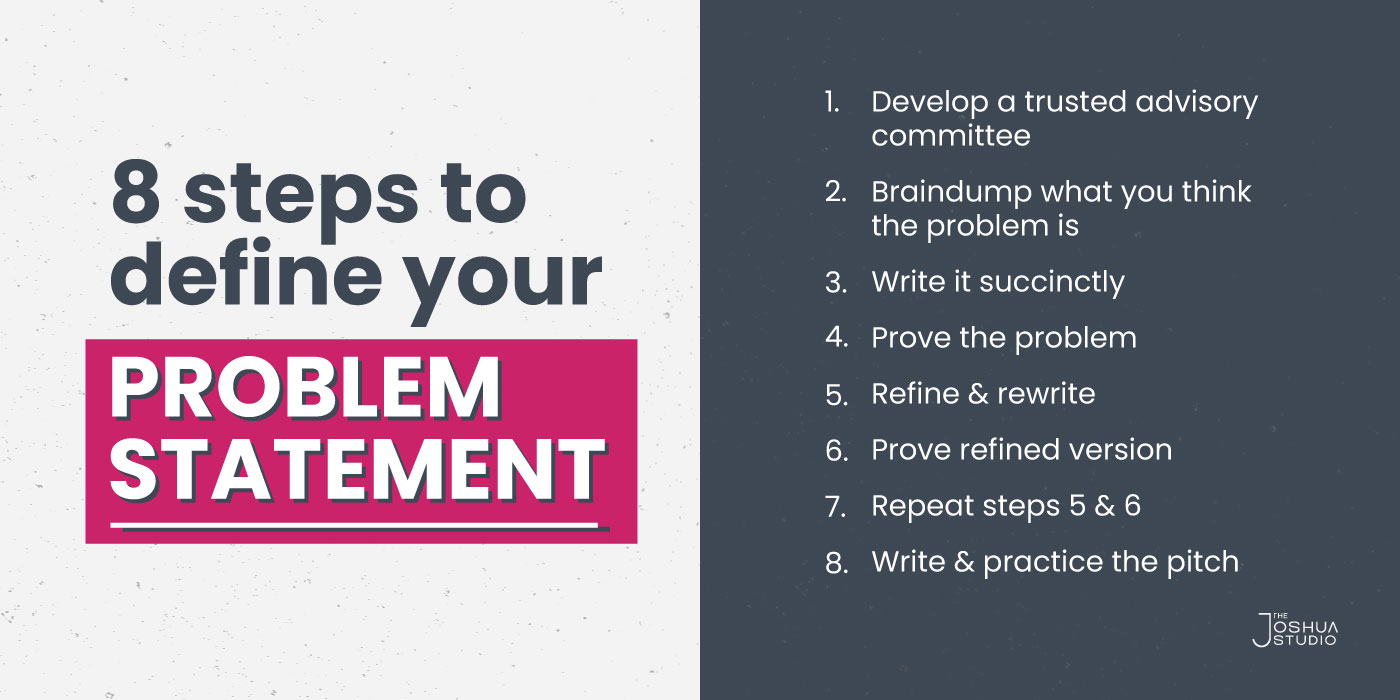What problem do you solve?
You are a master at solving a problem. It’s why you get up in the morning. It might be why you started a business or joined your team. No one can do it better than you can and it’s time you learn how to express what you do best with confidence.
If you’re not 100% certain that your business solves the right problem, you are likely solving the wrong problem. This is why you struggle to find joy and fulfillment in your work. When you are confident in your Problem Statement, you’ll know when to say “no” to solving a problem outside of your precise expertise.
Trust me when I say that this step is crucial and is more challenging than you think. It's also more rewarding than you think too.
Here are 8 steps to define your Problem Statement:
- Before you pick up a pen, coordinate a small advisory team to help you think through your problem statement.
- The advisory team should hold you accountable to some deadlines to keep you motivated.
- Write down what you think your problem is.
- It won’t be a perfect statement at first, so don’t let a blank page petrify you. Be brave and just start writing. Don’t stop writing until your done getting out all of the things in your head. It doesn’t even need to make sense right now. JUST WRITE!
- Re-write your problem in more succinct sentences.
- Don’t worry, this is just another draft and it will not be perfect yet. Keep writing.
- Prove your Problem Statement.
- Ask your trusted advisors or your market if you are addressing the right problem. This process may feel difficult as you will most certainly be told that you haven’t quite nailed it. Your advisors will undoubtedly give you feedback on the precise nature of the problem in a way that will challenge you. This is a good thing! Don’t worry about looking like you got it wrong. It’s very similar to asking someone to help open a jar of peanut butter after 10 minutes of painful twisting, pulling, attempting the damp towel torque move, and jack-hammering only to watch them pop the lid off with ease. It’s important that you know how crucial it was for you to loosen the lid and, in this case, set the stage for clarification of the problem.
- Market research is an important component to proving the problem exists. Look for relevant statistics from trusted sources for your industry.
- Refine your problem and ...you guessed it… rewrite it.
- Reveal the refined version to your advisors and don’t be afraid to include the relevant statistic if it helps.
- Repeat the Refine-and-Reveal cycle as many times as it takes to feel confident in your Problem Statement.
- Work on the pitch.
- Quickly, time yourself right now and try to explain aloud the pain-point your organization helps solve. If you’re able to explain it under 30 seconds, then you’re doing great. If you can explain it in 15 seconds or less, then you’re done.
It’s hard work and 100% worth it!
“If I had an hour to solve a problem I'd spend 55 minutes thinking about the problem and five minutes thinking about solutions.”
Albert Einstein
3 Examples of a problem to solve:
- “Only about 15% of employees are engaged at work. This is a problem because it causes an enormous loss of productivity and profit opportunity.”
- “Small online retailers spend too much on shipping costs as they are forced to compete with larger brands who offer free shipping. This extra cost is added to the price of the products which makes their store less competitive in the marketplace.”
- “Managers aren’t able to maintain the team’s motivation and their productivity at the same time due to lack of team dynamics training. This causes a costly increase in early attrition and employee turnover.”
What tips and tricks are you using to write your Problem Statement?

